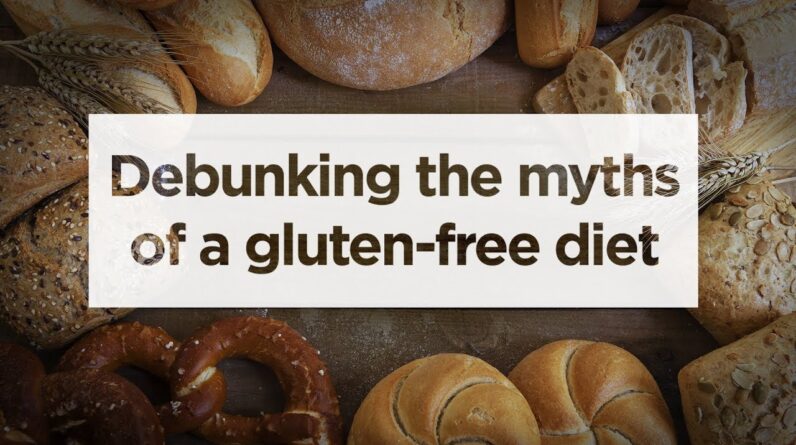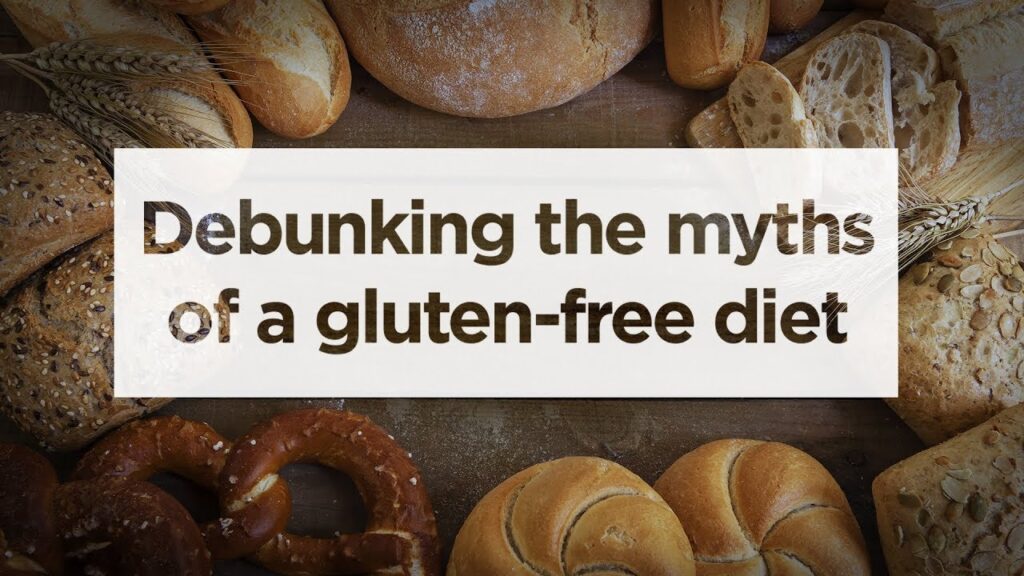
“The Gluten-Free Diet: Debunking Myths and Exploring the Truth” is a video by Global News that delves into the misconceptions surrounding gluten and the reasons why many people choose to eliminate it from their diet. The video explores the science behind gluten, explaining that it is an insoluble protein found in grains like wheat, barley, and rye. The main focus of the video is on individuals with celiac disease, an autoimmune disease that causes inflammation and damage to the gut when gluten is consumed. It also discusses the prevalence of celiac disease in Canada, as well as non-celiac gluten sensitivity and the growing trend of following a gluten-free diet. Furthermore, the video debunks popular myths associated with gluten-free diets, such as claims that it helps with weight loss, and highlights the potential risks of eliminating gluten from your diet unnecessarily. Overall, the video aims to provide viewers with a better understanding of gluten and its impact on the body, separating fact from fiction when it comes to the gluten-free diet.
What is Gluten?

This image is property of i.ytimg.com.
Definition of gluten
Gluten is an insoluble protein that is made up of two chemicals called gliadin and glutenin. It is found inside grains like wheat, barley, rye, and some oats. Gluten is responsible for the airiness, chewiness, and springiness in foods like pasta, croissants, and bread. It acts as a glue that holds these foods together.
Gluten as an insoluble protein
Gluten is considered an insoluble protein because it does not dissolve in water. This property allows it to provide structure and texture to various food products.
Gluten found in grains
Grains like wheat, barley, rye, and some oats contain gluten. These grains are the primary sources of gluten in our diet. Many common foods, such as pizza, bread, and soy sauce, contain gluten.
Gluten’s role in food texture
Gluten plays a crucial role in the texture of food. It provides elasticity and chewiness to baked goods, helping them to rise and hold their shape. Without gluten, these foods would be dense and lack the characteristic texture that we associate with them.
Who Avoids Gluten?
Celiac disease
Celiac disease is an autoimmune disease that affects about 1% of the population. People with celiac disease have a severe intolerance to gluten, and consuming even small amounts can cause inflammation and damage to the small intestine. Symptoms of celiac disease include gastrointestinal issues, weight loss, skin rashes, and nutritional deficiencies.
Non-celiac gluten sensitivity
Non-celiac gluten sensitivity refers to individuals who experience painful gastrointestinal symptoms after consuming gluten but do not test positive for celiac disease. These individuals may have similar symptoms to those with celiac disease but do not have the associated intestinal damage.
Choose to follow a gluten-free diet
There is a growing trend of individuals who choose to follow a gluten-free diet without having celiac disease or gluten sensitivity. These individuals may believe that avoiding gluten can improve their overall health or help with weight loss.
Celiac Disease and Gluten
Symptoms of celiac disease
Celiac disease can cause a range of symptoms, including stomach pain, bloating, diarrhea, skin rashes, and behavioral issues. Weight loss and nutritional deficiencies, such as iron deficiency, are also common.
Impact of gluten on the small intestine
When individuals with celiac disease consume gluten, the lining of the small intestine is affected. The hairlike structures called villi, which are responsible for absorbing nutrients, become damaged and flattened. This results in the malabsorption of essential nutrients.
Nutritional deficiencies caused by celiac disease
Celiac disease can lead to various nutritional deficiencies due to the compromised absorption of nutrients in the small intestine. Common deficiencies include iron, vitamin D, calcium, and B vitamins. These deficiencies can have wide-ranging effects on overall health and wellbeing.
Non-celiac Gluten Sensitivity
Symptoms of non-celiac gluten sensitivity
People with non-celiac gluten sensitivity experience similar gastrointestinal symptoms to those with celiac disease. These symptoms can include bloating, diarrhea, and abdominal pain. However, unlike celiac disease, non-celiac gluten sensitivity does not cause damage to the small intestine.
Difference between celiac disease and gluten sensitivity
The key difference between celiac disease and non-celiac gluten sensitivity is the absence of intestinal damage in the latter. While individuals with celiac disease must avoid gluten completely, those with gluten sensitivity may be able to tolerate small amounts of gluten without experiencing severe symptoms.
Prevalence of gluten sensitivity
It is estimated that about 2.1 million Canadians have non-celiac gluten sensitivity. These individuals experience gastrointestinal symptoms similar to those with celiac disease but do not test positive for the autoimmune condition. The exact prevalence of gluten sensitivity is still not well understood.
The Gluten-Free Diet Trend
Popularity of gluten-free diet
The gluten-free diet has gained significant popularity in recent years. More and more people are eliminating gluten from their diets, whether they have celiac disease, gluten sensitivity, or have chosen to do so for other reasons. The availability of gluten-free products has also increased to meet this growing demand.
Influence of the book ‘Wheat Belly’
The gluten-free diet trend gained significant traction with the publication of the book ‘Wheat Belly’ by cardiologist Dr. William Davis. The book argues that wheat is detrimental to health and has contributed to various health issues. It became a bestseller and further popularized the gluten-free diet.
Celebrity endorsement of the diet
The gluten-free diet has garnered attention and endorsement from celebrities, which has further fueled its popularity. However, it is important to note that celebrity endorsements are not based on scientific evidence and should not be the sole reason for adopting a particular diet.
Health Risks of a Gluten-Free Diet
Lack of fiber in gluten-free flours
Gluten-free flours often lack sufficient fiber compared to traditional wheat flour. This is due to the removal of grain sources containing gluten, which are typically high in fiber. Adequate fiber intake is essential for maintaining digestive health and preventing issues like constipation.
Nutritional deficiencies in gluten-free products
Gluten-free products may lack essential nutrients such as B vitamins and iron, which are typically added to traditional wheat flour. The absence of these nutrients can lead to deficiencies and impact overall health. It is crucial for individuals on a gluten-free diet to ensure they are receiving adequate nutrition.
Potential weight gain on a gluten-free diet
Contrary to popular belief, a gluten-free diet may actually lead to weight gain. Many gluten-free products are high in sugar and low in fiber, which can increase hunger and ultimately result in consuming more calories. It is essential to make informed choices and focus on a balanced diet when following a gluten-free lifestyle.
Debunking the Weight Loss Myth
Low fiber and high sugar content in gluten-free products
Gluten-free products often contain lower amounts of fiber compared to their gluten-containing counterparts. Additionally, they may have higher levels of sugar to compensate for taste and texture. These factors can lead to increased hunger and potentially result in weight gain, rather than weight loss.
Comparison of calorie content in gluten-free and gluten-containing foods
Comparing the calorie content of gluten-free and gluten-containing foods can help dispel the myth that a gluten-free diet promotes weight loss. Many gluten-free alternatives, such as gluten-free cookies, actually have similar or higher calorie content than their gluten-containing counterparts.
Cost comparison of gluten-free products
Gluten-free products are often more expensive than their gluten-containing counterparts. This can be a significant factor to consider when deciding to adopt a gluten-free diet. It is essential to evaluate the nutritional value and cost-effectiveness of gluten-free options.
Understanding the Placebo Effect
Explaining the feeling of improvement on a gluten-free diet
Some individuals report feeling better when following a gluten-free diet, even if they do not have celiac disease or gluten sensitivity. This perceived improvement may be attributed to the placebo effect, where the belief in the effectiveness of a treatment can influence one’s perception of its benefits.
Role of attention to eating healthier foods
When individuals adopt a gluten-free diet, they often pay more attention to their dietary choices and opt for healthier alternatives. This shift towards consuming more fruits, vegetables, and whole foods can contribute to improved well-being, regardless of the elimination of gluten.
Lack of magical properties in the gluten-free diet
It is important to debunk the notion that a gluten-free diet has magical properties or is inherently healthier for everyone. While it can be beneficial for individuals with celiac disease or gluten sensitivity, it is not a necessary or beneficial choice for those without these conditions.
Increase in Gluten-Free Options
Growing demand for gluten-free products
The increase in the number of individuals avoiding gluten has led to a growing demand for gluten-free products. This demand has prompted food manufacturers to develop and offer a wider variety of gluten-free options to cater to different dietary needs.
Availability and taste of gluten-free alternatives
In recent years, the taste and quality of gluten-free alternatives have significantly improved. These products no longer resemble cardboard and can be enjoyable to consume. The increased availability and improved taste of gluten-free alternatives make it easier for individuals with celiac disease or gluten sensitivity to adhere to their dietary restrictions.
Perception and misconceptions about gluten-free food
There is still a widespread perception that gluten-free food may not taste as good or may compromise on texture, flavor, or appearance. However, this perception is gradually changing as more people try and enjoy gluten-free alternatives. It is essential to create awareness and debunk misconceptions surrounding gluten-free food.
Conclusion
Importance of understanding the truth about the gluten-free diet
It is crucial to have accurate information about the gluten-free diet to make informed choices about one’s dietary preferences. Understanding the role of gluten in various health conditions and debunking myths surrounding the diet can help individuals make informed decisions about their well-being.
Considerations for individuals with celiac disease or gluten sensitivity
For individuals with celiac disease or gluten sensitivity, avoiding gluten is necessary to maintain good health and prevent symptoms and complications. It is important for these individuals to seek proper diagnosis and guidance from healthcare professionals to ensure they follow a balanced and nutritious gluten-free diet.
Promoting informed choices and debunking myths
By promoting accurate information about the gluten-free diet and debunking myths, we can help individuals make informed choices about their dietary preferences. It is essential to emphasize the importance of considering individual health needs and consulting healthcare professionals when making significant dietary changes.
